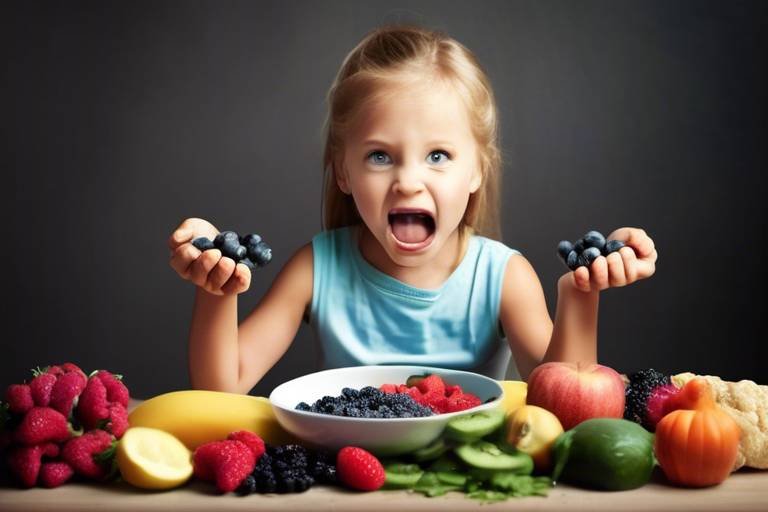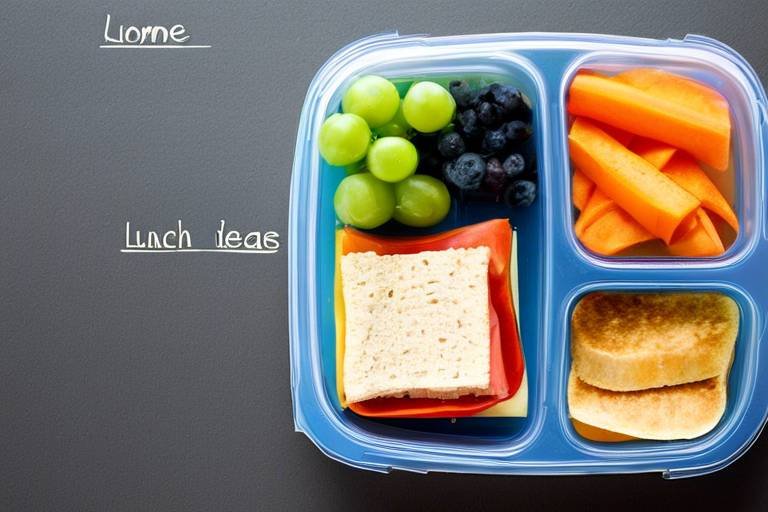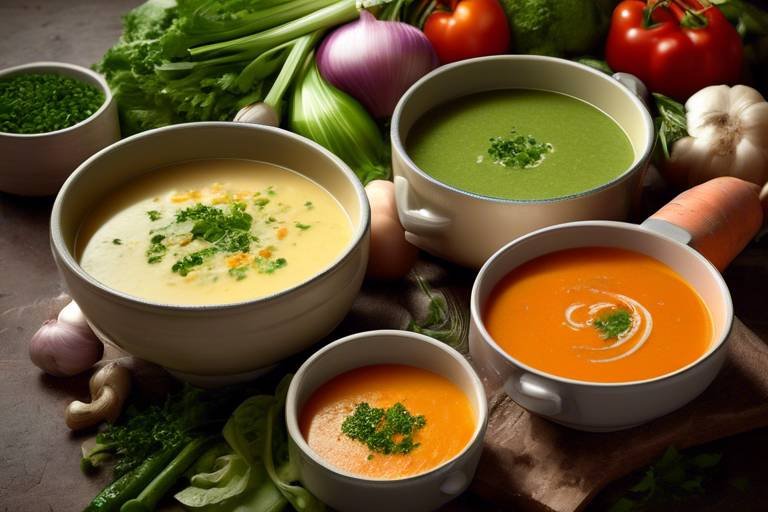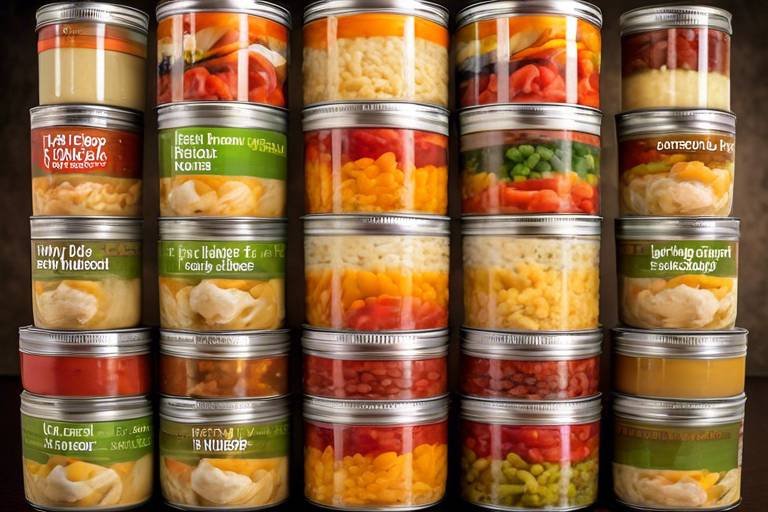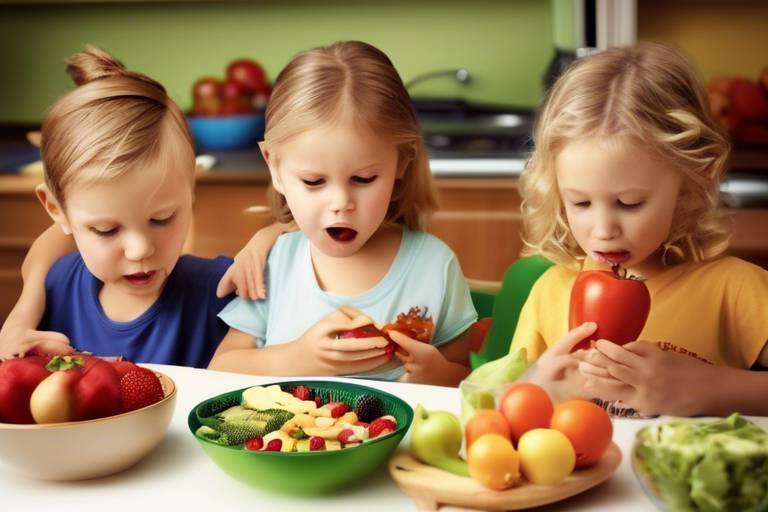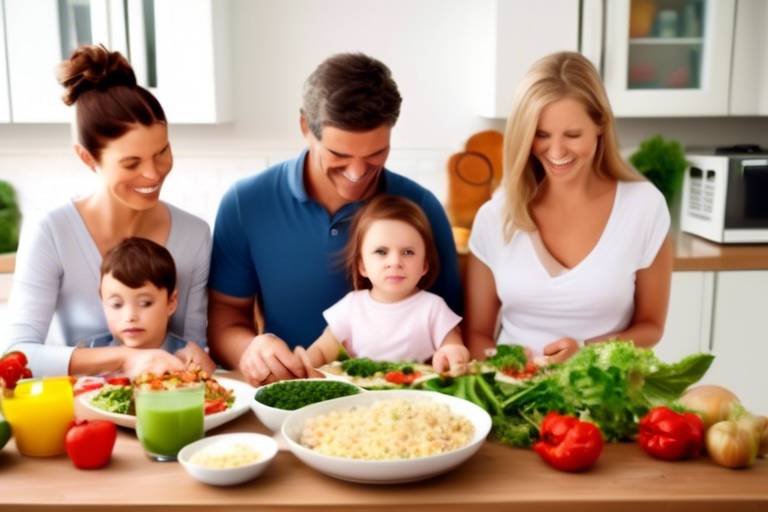A Guide to Feeding Your Vegan Children
Feeding your children a vegan diet can feel like navigating a maze, can't it? With all the information out there, it’s easy to feel overwhelmed. But don’t worry! This article provides essential insights and practical tips for parents navigating the challenges of feeding their vegan children, ensuring balanced nutrition and healthy eating habits. Whether you're a seasoned vegan parent or just starting to explore plant-based eating for your kids, you’ll find valuable guidance here to help you on this journey.
Before diving into meal planning, it's important to understand what veganism truly means for children. Veganism isn’t just about skipping meat and dairy; it's a lifestyle choice grounded in ethical, environmental, and health considerations. Many parents choose this path to instill values of compassion and sustainability in their children. Imagine teaching your kids that their food choices can positively impact the world! By opting for a plant-based diet, you're not only promoting healthier eating habits but also nurturing a sense of responsibility towards the planet.
As your little ones grow, their bodies need a variety of nutrients to thrive. It’s crucial to ensure that their vegan diet is rich in essential nutrients that support growth and development. Key nutrients to focus on include:
- Protein: Vital for growth and muscle development.
- Iron: Important for energy and cognitive function.
- Calcium: Essential for strong bones and teeth.
- Vitamins: Particularly B12, D, and omega-3 fatty acids.
With a bit of knowledge and creativity, you can easily source these nutrients from a variety of plant-based foods.
Protein is often a major concern for parents considering a vegan diet for their kids. But fear not! There are numerous plant-based protein sources that can meet your child's needs. Think of legumes, nuts, seeds, and whole grains as your best friends in this journey. For instance, a simple lentil stew can be both delicious and packed with protein. Let’s explore some specific sources:
Legumes such as lentils, chickpeas, and beans are not just great protein sources; they’re also incredibly versatile! You can whip up a hearty bean chili, toss chickpeas into salads, or blend lentils into a creamy dip. The options are endless! Plus, they come with the added bonus of fiber, which is fantastic for digestion.
Nuts and seeds are another fantastic way to boost your child's protein intake. They’re also loaded with healthy fats, which are essential for brain development. Think about adding sunflower seeds to your child’s cereal or whipping up a nut butter smoothie. Just be mindful of allergies—if your child is in a school setting, it's a good idea to check the rules around nut products.
While a vegan diet can be incredibly nutritious, certain vitamins and minerals may require special attention. For example, Vitamin B12 is primarily found in animal products, so consider fortified foods or supplements to ensure your child gets enough. Similarly, Vitamin D and omega-3 fatty acids are crucial for overall health. You can find plant-based sources of omega-3s in flaxseeds and walnuts. Remember, it’s all about balance!
Effective meal planning can simplify the process of feeding vegan children. By planning ahead, you can ensure that your family enjoys balanced, nutritious meals without the stress of last-minute decisions. Consider creating a weekly meal plan that includes a variety of food groups. This way, you can keep meals appealing and enjoyable for your kids while meeting their nutritional needs.
Constructing balanced meals is key to a healthy vegan diet. Aim for plates that include:
- Whole grains: Brown rice, quinoa, or whole grain pasta.
- Fruits and vegetables: A rainbow of colors for maximum nutrients.
- Protein sources: Legumes, nuts, or tofu.
By mixing and matching these components, you can create meals that are not only nutritious but also visually appealing, making it easier for your kids to enjoy their food.
Engaging your children in meal preparation can foster a positive relationship with food. Kids are more likely to eat what they’ve helped prepare! Try involving them in simple tasks like washing vegetables, stirring ingredients, or even picking out recipes. It can turn mealtime into a fun family activity rather than a chore.
As with any dietary choice, there are common concerns and misconceptions about vegan diets for children. One of the biggest worries is whether kids will get enough nutrition. Rest assured, with proper planning and education, a vegan diet can be incredibly healthy for children. It’s all about balance and variety!
Picky eating can be a challenge for any parent, but it doesn’t have to derail your vegan journey. Encourage your children to try new foods by making it fun! For example, create a colorful fruit and vegetable platter and let them choose what to try. Sometimes, it’s all about presentation. Kids love to eat with their eyes first!
Navigating social situations like birthday parties or school events can be tricky for vegan families. Here are a few tips to manage these scenarios while maintaining your dietary choices:
- Communicate with hosts about dietary needs.
- Bring along a vegan dish that your child loves.
- Educate your child on their dietary choices to boost their confidence.
With a little preparation, you can ensure that your child feels included and satisfied, no matter the occasion.
1. Can my child get enough protein on a vegan diet?
Absolutely! There are plenty of plant-based protein sources like legumes, nuts, and seeds that can meet your child's needs.
2. How can I ensure my child gets enough Vitamin B12?
Consider fortified foods or a B12 supplement, as this vitamin is primarily found in animal products.
3. What should I do if my child is a picky eater?
Get creative with presentation and let them help in the kitchen to make trying new foods more appealing.
4. How can I handle social situations involving food?
Communicate with hosts, bring your own dishes, and educate your child about their choices for confidence.

Understanding Veganism for Kids
Veganism is more than just a diet; it’s a lifestyle choice that resonates deeply with many families today. When it comes to kids, understanding the principles of veganism is crucial for parents who want to raise their children in a way that aligns with their values. Many choose a vegan lifestyle for a variety of reasons, including ethical considerations, environmental concerns, and health benefits. Let’s dive into these aspects to see why veganism can be a fantastic choice for kids.
From an ethical standpoint, many parents teach their children to respect all living beings. This often includes a commitment to avoiding animal products, which can foster compassion and empathy in young minds. When kids understand that their food choices can impact the lives of animals, they may develop a stronger sense of responsibility toward the world around them.
Environmentally, the benefits of a plant-based diet are significant. Studies have shown that animal agriculture contributes to deforestation, water scarcity, and greenhouse gas emissions. By opting for a vegan diet, families can feel empowered knowing that they are making choices that help reduce their carbon footprint. Teaching children about sustainability through their food choices can create a generation that is more conscious of their impact on the planet.
Health-wise, a vegan diet can be incredibly nutritious if properly planned. It's packed with fruits, vegetables, whole grains, nuts, and seeds, which are all great sources of essential nutrients. However, it’s essential to ensure that children receive a balanced diet that meets their growth and developmental needs. Parents should be vigilant about including a variety of foods to cover all nutritional bases.
In summary, understanding veganism for kids involves exploring ethical, environmental, and health perspectives. It’s about instilling values of compassion, responsibility, and health consciousness. As parents, engaging in conversations with your children about these principles can help them appreciate the importance of their dietary choices. Ultimately, it's not just about what’s on their plate, but also about nurturing a mindset that values kindness, sustainability, and well-being.

Essential Nutrients for Growing Vegans
When it comes to raising vegan children, ensuring they get all the essential nutrients is crucial for their growth and development. A well-planned vegan diet can provide all the necessary vitamins and minerals, but it requires a bit of knowledge and creativity on the part of parents. Think of it as a fun puzzle where each piece represents a different nutrient that contributes to your child's overall health. Let's dive into some of the critical nutrients that need special attention and how to incorporate them into your child's diet.
First up, we have protein. It's a common misconception that vegan diets lack sufficient protein. In reality, there are numerous plant-based sources that can meet the protein needs of growing kids. Foods like lentils, beans, chickpeas, quinoa, and tofu are fantastic options. For instance, a simple lentil soup or a chickpea salad can be both delicious and protein-packed. It’s all about getting creative in the kitchen! You might even consider involving your kids in meal prep to make it more fun.
Next on our nutrient checklist is iron. Iron is vital for energy levels and cognitive development, and while plant-based sources like spinach, beans, and fortified cereals are great, they also contain non-heme iron, which isn't absorbed as efficiently as the heme iron found in animal products. To boost absorption, pair iron-rich foods with vitamin C sources, such as oranges or bell peppers. For example, a spinach salad topped with strawberries not only tastes great but also enhances iron absorption.
Calcium is another essential nutrient that often raises eyebrows among vegan parents. Contrary to popular belief, you don’t need dairy to meet your calcium needs. Leafy greens, fortified plant milks, almonds, and tahini are excellent sources. A delicious smoothie made with fortified almond milk, spinach, and bananas can provide a calcium boost while being a hit with your kids!
Don’t forget about vitamin B12, which is crucial for nerve function and the production of DNA and red blood cells. This vitamin is primarily found in animal products, so it’s important for vegan families to consider fortified foods or a supplement. Incorporating nutritional yeast into popcorn or pasta dishes can be a tasty way to sneak in this vital nutrient.
Lastly, let’s talk about omega-3 fatty acids, which are essential for brain development and function. While they are commonly found in fish, vegans can obtain omega-3s from sources like flaxseeds, chia seeds, and walnuts. Adding ground flaxseed to your child’s oatmeal or chia seeds to a smoothie can be an easy way to ensure they’re getting enough of these important fats.
In summary, a balanced vegan diet for children can be achieved by focusing on these essential nutrients. By incorporating a variety of foods and being mindful of nutrient sources, parents can ensure their children are not just surviving, but thriving on a vegan diet. Here’s a quick overview of the essential nutrients and some sources:
| Nutrient | Plant-Based Sources |
|---|---|
| Protein | Lentils, beans, chickpeas, quinoa, tofu |
| Iron | Spinach, beans, fortified cereals, nuts |
| Calcium | Leafy greens, fortified plant milks, almonds, tahini |
| Vitamin B12 | Fortified foods, nutritional yeast |
| Omega-3 Fatty Acids | Flaxseeds, chia seeds, walnuts |
By keeping these nutrients in mind and getting a bit creative, you can ensure that your vegan children enjoy a balanced and nutritious diet that supports their growth and development.
1. Can vegan children get enough protein?
Absolutely! There are many plant-based protein sources available, such as legumes, nuts, and whole grains.
2. How can I ensure my child gets enough calcium?
Incorporate fortified plant milks, leafy greens, and nuts into their diet to meet calcium needs.
3. Is vitamin B12 supplementation necessary for vegan kids?
Yes, since B12 is primarily found in animal products, it's important to consider fortified foods or supplements.
4. What are some fun ways to include omega-3s in my child's diet?
You can add ground flaxseed to smoothies or oatmeal, and use chia seeds in puddings or baked goods.

Protein Sources in a Vegan Diet
When it comes to feeding your vegan children, one of the most important considerations is ensuring they get enough protein. Protein is essential for growth, development, and overall health, especially in children who are still growing. The good news is, there are plenty of delicious and nutritious plant-based protein sources that can easily be incorporated into their diets. Think of protein as the building blocks of your child's body—like bricks in a house. Without enough bricks, the house (or in this case, their body) can’t be built strong and sturdy.
So, what are some fantastic sources of protein that you can include in your children's meals? Let’s dive into some of the best options:
- Legumes: These are your go-to protein powerhouses! Lentils, chickpeas, and beans are not only rich in protein but also packed with fiber, which is great for digestion. You can make a hearty lentil soup or whip up some chickpea salad for a tasty lunch.
- Nuts and Seeds: Almonds, walnuts, chia seeds, and hemp seeds are fantastic sources of healthy fats and protein. Sprinkle them on oatmeal, blend them into smoothies, or create a nut butter spread for a satisfying snack.
- Whole Grains: Quinoa, brown rice, and oats are not just filling; they're also good sources of protein. Quinoa, in particular, is a complete protein, meaning it contains all nine essential amino acids that your child needs for growth.
Incorporating these protein sources into your child's diet can be both fun and creative. For instance, you can create a colorful protein-packed bowl by mixing quinoa with black beans, corn, diced tomatoes, and avocado. Not only is it nutritious, but it also looks appealing and tastes amazing!
Additionally, it’s essential to remember that variety is key. Just like a painter needs different colors to create a masterpiece, your child needs a range of protein sources to ensure they’re getting all the necessary amino acids. Consider rotating different legumes, nuts, and grains throughout the week. This not only keeps meals exciting but also helps prevent any potential nutrient gaps.
Lastly, don't forget about the power of snacks! Healthy snacking can be a great way to sneak in extra protein. Try making homemade energy balls with oats, nut butter, and seeds, or offer roasted chickpeas as a crunchy, satisfying treat. Your kids will love them, and you’ll feel good knowing they’re fueling their bodies with wholesome ingredients.
1. Can vegan children get enough protein?
Yes, with a well-planned vegan diet, children can easily obtain sufficient protein from various plant-based sources such as legumes, nuts, seeds, and whole grains.
2. What are some quick protein-rich snacks for kids?
Some quick snacks include hummus with veggie sticks, nut butter on whole-grain toast, or a handful of mixed nuts and dried fruit.
3. How can I ensure my child is getting all essential amino acids?
By including a variety of protein sources in their diet, such as combining legumes with grains (like rice and beans), your child will get all the essential amino acids they need.

Legumes and Pulses
Legumes and pulses are not just your average pantry staples; they are the superheroes of the vegan diet! Packed with protein, fiber, and a plethora of vitamins and minerals, these little gems can make mealtime both nutritious and exciting for your children. Think of them as the building blocks of a healthy diet, especially for growing kids who need plenty of energy and nutrients to fuel their busy lives.
Incorporating legumes like lentils, chickpeas, and various types of beans into your child's meals can be a game-changer. Not only are they versatile, but they can also be transformed into countless delicious dishes that your kids will love. For instance, how about whipping up a vibrant chickpea salad or a comforting bowl of lentil soup? These meals can be colorful, fun, and packed with flavor, making them far more appealing to young eaters.
When it comes to preparing legumes, the options are nearly limitless. You can blend them into smoothies for a protein boost, use them as a base for veggie burgers, or even toss them into pasta dishes for added texture and nutrients. Here’s a quick rundown of some popular legumes and their benefits:
| Legume | Protein Content (per 100g) | Additional Benefits |
|---|---|---|
| Lentils | 9g | High in fiber, iron, and folate. |
| Chickpeas | 8.9g | Rich in magnesium, phosphorus, and vitamins B6 and C. |
| Black Beans | 8.9g | Excellent source of antioxidants and fiber. |
| Kidney Beans | 8.7g | High in potassium and beneficial for heart health. |
Moreover, legumes are incredibly cost-effective, making them a fantastic choice for families on a budget. You can buy them dried, canned, or frozen, which means you can always have some on hand for quick meals. Just imagine the satisfaction of knowing that you’re providing your kids with wholesome, plant-based nutrition without breaking the bank!
To make legumes more appealing to your children, consider involving them in the cooking process. Kids often love to help out in the kitchen, and by letting them mash chickpeas for a homemade hummus or stir lentils into a colorful stew, you can create a sense of ownership over their meals. This not only encourages them to try new foods but also strengthens their relationship with healthy eating.
In summary, legumes and pulses are a vital part of a vegan diet for children. By incorporating a variety of these nutrient-dense foods into your family meals, you can ensure that your kids are not only getting enough protein but also enjoying delicious and satisfying dishes. So, next time you’re planning your grocery list, don’t forget to stock up on these nutritious powerhouses!

Nuts and Seeds
Nuts and seeds are not just tasty snacks; they are powerhouse foods that can play a significant role in a vegan child's diet. Packed with healthy fats, protein, and a variety of essential nutrients, they can be a delightful addition to meals and snacks alike. Think of nuts and seeds as the little superheroes of the plant-based world—small in size but mighty in benefits!
When it comes to incorporating nuts and seeds into your child's meals, creativity is key. For instance, you can blend nuts into smoothies for a creamy texture or sprinkle seeds over salads to add a satisfying crunch. Some popular options include:
- Almonds: Rich in vitamin E and magnesium, almonds can be enjoyed raw, roasted, or as almond butter. They are versatile enough to be added to oatmeal or used as a dip for fruits.
- Chia Seeds: These tiny seeds are a great source of omega-3 fatty acids and fiber. You can mix them into yogurt or make chia pudding for a fun dessert.
- Sunflower Seeds: Packed with vitamin E and selenium, sunflower seeds can be a crunchy topping for salads or a nutritious addition to trail mix.
However, while nuts and seeds offer fantastic health benefits, it's essential to be mindful of potential allergies. According to recent studies, nut allergies are becoming increasingly common among children. Therefore, always introduce new foods gradually and consult with your pediatrician if you have any concerns.
Another great way to incorporate these nutrient-dense foods is through homemade energy bars or granola. You can create a fun family activity by letting your kids help mix their favorite nuts and seeds with oats, dried fruits, and a bit of maple syrup. Not only will they enjoy the process, but they’ll also take pride in eating something they helped create!
In summary, nuts and seeds can be a fantastic addition to your vegan child's diet. They are not only nutritious but also versatile, making them easy to incorporate into various meals and snacks. By experimenting with different recipes and involving your children in the kitchen, you can ensure they receive the essential nutrients they need while having fun in the process!

Vitamins and Minerals for Vegan Kids
When it comes to feeding our little ones a vegan diet, understanding the importance of vitamins and minerals is crucial. Just like a car needs the right fuel to run smoothly, our children's bodies require essential nutrients to grow, develop, and thrive. While a vegan diet can be incredibly nutritious, certain vitamins and minerals may need extra attention to ensure our kids are getting everything they need.
One of the most talked-about nutrients for vegans is Vitamin B12. This vitamin is essential for nerve function and the production of DNA and red blood cells. The challenge here is that B12 is primarily found in animal products, so it's vital for vegan families to consider fortified foods or supplements. Foods like fortified plant milks, cereals, and nutritional yeast can be fantastic sources of B12. It’s like adding a secret ingredient to a recipe that enhances the entire dish!
Another critical nutrient to keep an eye on is Vitamin D. This vitamin plays a significant role in calcium absorption and bone health. While our bodies can produce Vitamin D from sunlight, many children may not get enough exposure, especially during the winter months. Fortified foods and supplements can help bridge this gap. Think of it as providing a little sunshine in a bottle!
Omega-3 fatty acids are also a hot topic in vegan nutrition. These healthy fats are vital for brain development and function. While fish is a common source of omega-3s, there are plenty of plant-based options available. Flaxseeds, chia seeds, and walnuts are excellent choices. Including these in your child's diet can be as easy as adding a spoonful of ground flaxseed to their smoothies or sprinkling chia seeds on their yogurt. It’s like giving their brain a boost of energy!
| Nutrient | Sources | Importance |
|---|---|---|
| Vitamin B12 | Fortified cereals, nutritional yeast, plant milks | Nerve function, red blood cell production |
| Vitamin D | Fortified foods, supplements | Bone health, calcium absorption |
| Omega-3 Fatty Acids | Flaxseeds, chia seeds, walnuts | Brain development and function |
Lastly, let’s not forget about iron and calcium. Iron is crucial for carrying oxygen in the blood, and while it can be found in plant sources like lentils and spinach, it’s important to pair these with vitamin C-rich foods (like oranges or bell peppers) to enhance absorption. Calcium, on the other hand, is essential for strong bones and teeth. Vegan sources include fortified plant milks, tofu, and leafy greens. Think of it as building a sturdy house; you need a strong foundation to support everything else!
In summary, while a vegan diet can be incredibly beneficial for children, it does require a bit of planning and knowledge to ensure they receive all the necessary vitamins and minerals. Being mindful of these nutrients not only helps in promoting healthy growth but also instills lifelong healthy eating habits. Remember, it’s not just about what they eat today, but about setting them up for a healthy tomorrow!
- Can vegan children get enough protein? Yes! There are plenty of plant-based protein sources like legumes, nuts, and whole grains that can meet their needs.
- How can I ensure my child gets enough Vitamin B12? Look for fortified foods or consider a B12 supplement after consulting with a healthcare provider.
- What are good sources of calcium in a vegan diet? Fortified plant milks, tofu, and leafy greens are excellent sources of calcium.

Meal Planning Tips for Vegan Families
Meal planning can feel like a daunting task, especially for vegan families trying to ensure their children receive all the necessary nutrients. However, with the right strategies, it can also be a fun and rewarding experience! One of the best ways to start is by creating a weekly meal plan. This not only saves time but also helps in organizing shopping lists and ensuring variety in meals. Think of it as a roadmap for your culinary adventures! By having a clear outline of what to prepare, you can avoid the last-minute scramble that often leads to unhealthy eating choices.
When planning meals, aim to include a variety of foods from all the essential food groups. This means incorporating fruits, vegetables, whole grains, legumes, nuts, and seeds into your children’s diets. A balanced plate might look like this: half filled with colorful vegetables, a quarter with whole grains like quinoa or brown rice, and the remaining quarter with a protein source such as lentils or chickpeas. Not only does this ensure nutritional balance, but it also makes meals visually appealing to kids, who often eat with their eyes first!
Another great tip is to involve your children in the meal preparation process. This can foster a positive relationship with food and help them learn valuable cooking skills. Let them help with washing vegetables, stirring ingredients, or even choosing what to eat for the week. You might be surprised at how eager they are to try new foods when they’ve had a hand in making them! For instance, if they help to make a colorful veggie stir-fry, they are more likely to eat it. Plus, cooking together can create lasting memories and strengthen family bonds.
Don’t forget about snacks! Healthy snacks are a crucial part of a child’s diet, especially for active kids. Prepare a variety of snacks ahead of time, such as hummus with carrot sticks, fruit smoothies, or whole-grain energy bars. Having these on hand can prevent the temptation to reach for less nutritious options when hunger strikes. You can even make it a fun activity by creating a “snack station” in your kitchen where kids can mix and match their favorite healthy snacks.
Lastly, keep an eye on the seasons and local produce. Seasonal fruits and vegetables are not only fresher and tastier, but they can also be more affordable. Consider visiting local farmers' markets to discover new ingredients and inspire your meal planning. You can even turn this into a family outing, making grocery shopping an adventure rather than a chore!
By implementing these meal planning tips, you’ll be well on your way to creating a nourishing and enjoyable vegan diet for your children. Remember, the key is to keep it fun, varied, and engaging. With a little creativity and planning, you can ensure your kids are excited about their meals while receiving all the nutrients they need to thrive.
- How can I ensure my vegan child gets enough protein?
Incorporate a variety of protein sources such as legumes, nuts, seeds, and whole grains into their meals. Foods like lentils, chickpeas, and quinoa are excellent options.
- What should I do if my child is a picky eater?
Encourage them to try new foods by involving them in meal prep and making meals visually appealing. Gradually introduce new flavors alongside their favorites.
- Are there any supplements I should consider for my vegan child?
Consult with a pediatrician about potential supplements, especially for nutrients like B12, vitamin D, and omega-3 fatty acids, which may require special attention in a vegan diet.

Creating Balanced Plates
Creating balanced plates for your vegan children is not just about filling their plates with food; it’s about providing them with a nutrient-rich variety that supports their growth and development. Think of a balanced plate as a colorful canvas where each food group adds a splash of color and flavor, making meals not only nutritious but also visually appealing. When planning meals, aim to include a mix of whole grains, proteins, healthy fats, and a rainbow of fruits and vegetables.
To construct a balanced plate, consider the following food groups and their proportions:
| Food Group | Examples | Recommended Proportion |
|---|---|---|
| Whole Grains | Brown rice, quinoa, whole grain pasta | 1/4 of the plate |
| Proteins | Legumes, nuts, tofu, tempeh | 1/4 of the plate |
| Vegetables | Broccoli, carrots, spinach, bell peppers | 1/2 of the plate |
| Fruits | Berries, bananas, apples, oranges | As a side or dessert |
By following this simple structure, you can ensure that your child is receiving a balanced diet. For instance, a meal could consist of a generous serving of quinoa topped with chickpeas and a medley of steamed vegetables such as broccoli and carrots. To add a touch of healthy fat, drizzle some olive oil or sprinkle seeds on top. Finish off the meal with a side of fresh fruit, making it a feast for both the eyes and the palate!
Another tip is to involve your kids in the meal planning and preparation process. Let them choose a few of their favorite vegetables or fruits to include in their meals. When children have a hand in creating their meals, they are more likely to eat what’s on their plates. Plus, it’s a fantastic way to teach them about nutrition and the importance of a balanced diet.
Lastly, don’t forget about the power of flavor! Use herbs and spices to enhance the taste of your dishes. A sprinkle of cumin or a dash of paprika can transform a simple dish into a delightful culinary experience. Creating balanced plates is all about making healthy eating enjoyable and exciting for your little ones!
- How can I ensure my vegan child is getting enough protein? Include a variety of protein sources like legumes, nuts, seeds, and whole grains in their meals.
- What should I do if my child refuses to eat vegetables? Get creative! Try different cooking methods or involve them in meal prep to spark their interest.
- Are there any supplements my vegan child might need? Some children may require vitamin B12, vitamin D, or omega-3 supplements, so it’s best to consult with a pediatrician.

Involving Children in Meal Prep
Involving your children in meal preparation can be a game-changer when it comes to fostering a positive relationship with food. When kids participate in the cooking process, they are more likely to be excited about the meals being served and open to trying new foods. Imagine the joy on their faces as they help transform simple ingredients into delicious dishes! It's not just about making dinner; it's about creating memories and teaching valuable life skills.
Start by assigning age-appropriate tasks. For younger children, this could mean washing vegetables or stirring ingredients in a bowl. As they grow older, they can take on more complex responsibilities, such as measuring ingredients or even chopping vegetables (with supervision, of course!). This hands-on approach not only builds their confidence but also helps them understand where their food comes from and the effort that goes into preparing meals.
Consider setting up a weekly "meal prep day" where the whole family can get together to cook. This not only makes the process more fun but also allows for teamwork. You might even want to create a menu together, letting your kids choose a few dishes they’d like to prepare. This could include a variety of plant-based meals, like a hearty lentil stew or colorful vegetable stir-fry. The more involved they are in the decision-making, the more likely they will enjoy the end result.
Another fun idea is to introduce themed cooking nights, such as "Taco Tuesday" or "Smoothie Sunday." Kids love themes, and this can spark their creativity. For example, on Taco Tuesday, you can provide a variety of fillings such as black beans, corn, avocado, and fresh salsa, allowing them to build their own tacos just the way they like them. This not only makes the meal interactive but also encourages them to explore different flavors and textures.
Don't forget to celebrate their contributions! Praise their efforts and let them know how much you appreciate their help. This positive reinforcement goes a long way in making them feel valued and encourages them to continue participating in the kitchen. You could even create a "Chef of the Week" award to highlight their achievements, making cooking a fun and rewarding experience.
Involving children in meal prep also opens the door to discussions about nutrition. You can talk about the benefits of different ingredients, why certain foods are essential for their growth, and how a balanced vegan diet can be both delicious and nutritious. This knowledge empowers them to make healthier choices, both in and out of the kitchen.
In summary, getting your kids involved in meal preparation is not just about making dinner; it’s about teaching them valuable skills, fostering creativity, and building a healthy relationship with food. So roll up your sleeves, put on some aprons, and enjoy the culinary adventure together!
- How can I encourage my picky eater to try new foods?
Start by introducing new foods in a fun and non-pressuring way. Make it a game or involve them in the cooking process to spark their curiosity. - What are some easy vegan recipes for kids?
Consider simple recipes like veggie tacos, fruit smoothies, or homemade pizza with a variety of toppings. These are not only easy to make but also customizable! - How can I ensure my child is getting enough protein on a vegan diet?
Incorporate a variety of protein sources such as legumes, nuts, seeds, and whole grains. Meal planning can help ensure they receive adequate protein intake.

Addressing Common Concerns
As parents, choosing a vegan lifestyle for your children can sometimes lead to a whirlwind of questions and concerns, and that's completely normal! Many people wonder if a vegan diet can provide all the essential nutrients that growing children need. It's crucial to address these concerns head-on, so parents can feel confident in their dietary choices. One common misconception is that vegan diets are inherently deficient in protein or calcium. However, with the right planning, a vegan diet can be just as nutritious, if not more so, than a traditional diet. It's all about knowing where to find those nutrients.
Another concern is about social situations. Kids often face peer pressure and social challenges, especially during birthday parties or school events where food options may be limited. But fear not! With a little creativity and preparation, you can equip your child with delicious vegan snacks that they'll be proud to share. You might even inspire their friends to try something new! For instance, homemade vegan cupcakes or energy balls can be a hit at parties, and they’re a great way to showcase how fun and delicious vegan treats can be.
Moreover, many parents worry about their children's picky eating habits. It's a common phase in childhood, and it can be particularly challenging when trying to introduce new vegan foods. To tackle this, consider involving your kids in meal preparation. When children help in the kitchen, they're more likely to be excited about trying the dishes they’ve made. You might even turn the experience into a fun game, where they get to choose a new vegetable each week to incorporate into meals. This not only broadens their palate but also creates lasting memories around food.
Finally, let’s talk about nutrient deficiencies, which can be a concern with any diet, vegan or not. It's essential to pay attention to specific nutrients that might need extra focus, such as Vitamin B12, Vitamin D, and omega-3 fatty acids. Regular check-ups with a healthcare provider can help monitor your child’s nutritional status, ensuring they are thriving on their plant-based diet. Educating yourself about fortified foods and supplements can also provide peace of mind.
To further ease any lingering doubts, here are some frequently asked questions that many parents have when considering a vegan diet for their children:
- Can my child get enough protein on a vegan diet? Absolutely! Foods like lentils, chickpeas, tofu, and quinoa are excellent sources of protein.
- What about calcium? Vegan sources of calcium include fortified plant milks, leafy greens, and almonds.
- How can I ensure my child gets enough Vitamin B12? Consider using fortified foods or a B12 supplement, as this vitamin is primarily found in animal products.
- What should I do if my child is a picky eater? Involve them in cooking and meal planning to encourage them to try new foods.
- How can I handle social situations where vegan options are limited? Prepare and send your child with their own snacks or meals that they can enjoy with their friends.

Managing Picky Eaters
Ah, the age-old challenge of dealing with picky eaters! If you're a parent of a vegan child, you might feel like you're navigating a culinary minefield. But fear not! With a sprinkle of creativity and a dash of patience, you can turn mealtime into a delightful experience rather than a battleground. First, it’s essential to understand that picky eating is a common phase for many children. They may be hesitant to try new foods for various reasons, including texture, color, or simply because they are in a stage of asserting their independence. The key here is to approach the situation with empathy and a bit of strategy.
One effective method to encourage your child to expand their palate is to introduce new foods gradually. Instead of presenting a whole new dish that might overwhelm them, consider adding one new ingredient to a familiar recipe. For example, if your child loves pasta, try mixing in some sautéed spinach or a few chickpeas. This way, they won't feel pressured, and the familiar flavors can help ease them into trying something new. Furthermore, involving your child in the cooking process can make them more excited about the food. Let them help wash vegetables, stir sauces, or even pick out new ingredients at the grocery store. When they have a hand in creating their meals, they may be more likely to try what they've helped prepare.
Another tip is to make meals visually appealing. Kids are often attracted to bright colors and interesting shapes. You can create a rainbow plate by including a variety of colorful fruits and vegetables. Not only does this look appetizing, but it also ensures they're getting a range of nutrients. Additionally, you can use fun shapes with cookie cutters for sandwiches or fruit, turning a simple meal into an adventure. Remember, presentation can make a significant difference in how a child perceives their food.
It's also important to set a positive example. Children are keen observers and often mimic their parents' behaviors. If they see you enjoying a wide variety of foods, they may be more inclined to try new things themselves. Share your excitement about the flavors and textures of different plant-based foods. You might say, “Wow, this quinoa salad is so crunchy and fresh! You have to try it!” Your enthusiasm can be contagious.
Lastly, patience is crucial. It might take several exposures to a new food before your child is willing to try it. Keep offering it without pressure, and celebrate small victories—like taking a single bite or even just smelling the food. Over time, your child may surprise you by developing a taste for foods they once turned their noses up at. Remember, every child is different, and what works for one may not work for another. The goal is to create a positive food experience that encourages exploration rather than resistance.
- What should I do if my child refuses to eat vegetables? Try different cooking methods like roasting or blending them into smoothies. Sometimes, the right texture can make all the difference!
- How can I ensure my vegan child gets enough protein? Incorporate a variety of protein sources such as lentils, beans, quinoa, and tofu into meals. Mixing them into familiar dishes can also help.
- Is it okay to let my child have non-vegan options at social events? It depends on your family’s values, but teaching them about their dietary choices can empower them to make decisions that align with your family's lifestyle.

Social Situations and Veganism
Navigating social situations can be a bit like walking a tightrope for vegan families. Whether it's a birthday party, a family gathering, or a school event, the challenge of maintaining your family's dietary choices while also ensuring your kids feel included can be daunting. But fear not! With a little planning and creativity, you can turn these moments into opportunities for fun and education.
One of the first steps is to communicate openly with friends and family about your child's vegan diet. Many people are genuinely curious and willing to accommodate dietary preferences if they understand the reasons behind them. You could say something like, "We're raising our kids vegan for health and ethical reasons, and we'd love your support in making our family gatherings inclusive!" This approach not only educates others but also fosters a sense of community and understanding.
When it comes to birthday parties or school events, consider bringing a delicious vegan dish that your child can share with others. This not only ensures they have something to eat but also introduces their friends to the idea that vegan food can be tasty and fun! Think about making colorful cupcakes with vegan frosting or a vibrant fruit platter that catches the eye. You could even involve your child in the preparation, turning it into a fun bonding experience.
Another great strategy is to offer to host or organize events where you can control the menu. This way, you can create a spread that is not only vegan-friendly but also appealing to everyone. You could prepare a variety of dishes such as:
- Vegan pizza with an array of toppings
- Veggie skewers with a tasty dip
- Plant-based burgers that everyone can customize
For school-related events, it might be helpful to have a conversation with teachers or event organizers ahead of time. Share your child's dietary needs and suggest options that can be made available, or offer to bring a vegan dish that everyone can enjoy. This proactive approach can help alleviate any potential awkwardness and ensures your child feels included.
Lastly, remember that social situations are also a fantastic opportunity for your child to educate their peers about veganism. Encourage them to share their favorite vegan snacks or meals, and let them explain why they enjoy this lifestyle. This not only builds their confidence but also helps demystify veganism for their friends, making it a more accepted choice in their social circles.
Q: How do I handle situations where vegan options are not available?
A: Always come prepared! Bring your own snacks or meals to ensure your child has something to eat. You can also suggest alternatives to the host in advance.
Q: What should I do if my child feels left out during social gatherings?
A: Encourage them to engage with others and share their food. Highlighting the fun aspects of veganism can help them feel proud and included.
Q: How can I educate my child's friends about veganism?
A: Use fun and engaging methods, like cooking together or sharing interesting facts about plant-based foods. Kids love stories and games, so incorporate those elements!
Frequently Asked Questions
- What are the main nutrients my vegan child needs?
It's essential for vegan children to get a balanced intake of nutrients. Focus on key nutrients like protein, iron, calcium, and various vitamins such as B12 and D. Incorporating a variety of fruits, vegetables, whole grains, legumes, nuts, and seeds can help meet these nutritional needs.
- How can I ensure my child gets enough protein on a vegan diet?
There are plenty of plant-based protein sources available! Consider including legumes like lentils and chickpeas, nuts, seeds, and whole grains like quinoa and brown rice in their meals. Mixing these foods in fun ways can make meals more appealing and ensure they get the protein they need for growth.
- Is it safe for my child to be vegan?
Absolutely! A well-planned vegan diet can be very healthy for children. It's crucial to pay attention to their nutritional needs and ensure they're getting enough of the essential nutrients. Consulting with a pediatrician or a nutritionist can provide additional guidance tailored to your child's specific needs.
- How can I deal with my child being a picky eater?
Picky eating is common, but there are strategies to encourage your child to try new vegan foods. Make meals visually appealing, involve them in cooking, and offer a variety of textures and flavors. Sometimes, it just takes a few tries before they warm up to a new dish!
- What should I do during social situations or events?
Social situations can be tricky, but communication is key! Talk to hosts ahead of time about your child's dietary needs, and consider bringing a delicious vegan dish to share. This way, your child has something to enjoy while also introducing others to tasty vegan options.
- Are there any vegan substitutes for dairy and eggs?
Definitely! There are numerous vegan alternatives available today. For dairy, you can use almond milk, soy yogurt, or nut cheeses. For eggs, options like flaxseed meal or chia seeds mixed with water can work well in baking. Explore different substitutes to find what your child enjoys!


